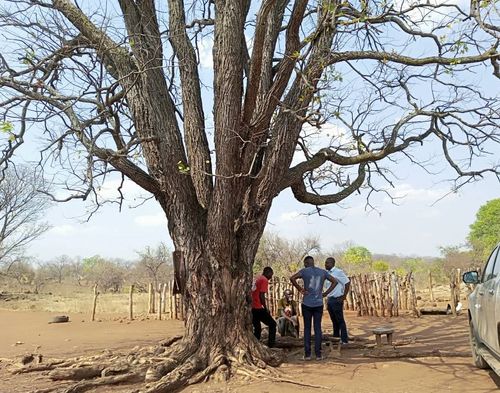By Pamela Kapekele
Despite its wealth of mineral and other natural resources, the Gwembe valley remains home to some of Zambia’s most underprivileged communities. The valley’s vast mineral riches stand in stark contrast to the challenges faced by its inhabitants, underscoring the complex dynamics of the region.
As we embark on this expedition, we bear witness to the indomitable spirit of the valley’s residents. Our interactions with these remarkable communities grant us a deeper understanding of their struggles and the cultural heritage they fervently preserve.
Guiding us on this journey is our esteemed companion, Winter Muvombo, a native of the area and a passionate advocate for the valley’s development. Winter’s expertise and profound connection to this remarkable region enrich our expedition and illuminate the untapped potential it holds.
The valley, with its breathtaking landscapes and vibrant communities, has long held a special place in Muvombo’s heart. His dedication to the valley’s progress is well-documented, making him the perfect guide to unveil the hidden treasures and stories that lie within this enchanting destination.
Our journey commences along the Mikango-Chiawa Road, the gateway to the lively town of Chirundu. Along this road, we catch a glimpse of the ambitious vision of Zambia’s five President, late Michael Sata, who aimed to enhance connectivity. Although the road construction project commenced during his tenure, it unfortunately remains unfinished after his passing.
While the road still bears traces of the aspirations of Sata, we encounter a notable stretch where his dream became a reality. Approximately two kilometres before the Chiawa Bridge, and another kilometre after, a smooth section of tarmac welcomes us, bearing witness to the progress made.
The bridge, another symbol of Sata’s vision, stands as a remarkable accomplishment. Constructed by China Henan Corporation, work on the bridge began in October 2012 and was completed in 2014, just a month before Sata’s untimely demise.
As we traverse this partially tarred road and cross the bridge, we reflect upon the significance of these infrastructure projects, not only as testaments to Sata’s ambitions but also as vital links that facilitate transportation and connectivity within the region. This brief encounter with Sata’s vision serves as a reminder of the aspirations and legacies that shape the development of the Gwembe Valley.
Continuing our expedition, we encounter a place of historical significance known as the Buleya Malima Irrigation Scheme. Muvombo shares with us the story of this government-funded agricultural cooperative, which unfortunately ceased operations in 1996. Once a thriving crop production unit, it played a vital role in cultivating maize within the jurisdiction of Chief Sinazongwe, near the picturesque shores of Lake Kariba.
The irrigation scheme stands as a testament to the agricultural endeavours of the past in the region. It was a hub of vibrant activity, where farmers diligently nurtured their crops and contributed to the local food supply. However, changing circumstances led to its closure, marking a shift in the agricultural landscape of the area.
Despite the closure of the cooperative, the fertile land surrounding the scheme has not gone to waste. Muvombo informs us that individuals have now taken up the initiative to cultivate small fields of sugarcane. These resilient farmers continue to harness the natural resources and agricultural potential of the region, adapting to new circumstances and pursuing livelihoods.
With newfound appreciation for the historical and agricultural significance of the irrigation scheme, we eagerly anticipate the next chapter of our journey through the valley.
As we progress, Muvombo shares with us another defunct government irrigation scheme known as the Siatwiinda Irrigation Scheme. This particular scheme faced its demise due to a critical logistical challenge that hindered the farmers’ ability to transport their abundant harvests to urban markets.
Muvombo explains that the farmers within the cooperative experienced consistent bumper harvests, reflecting the fertile potential of the land and the dedication of those involved. However, the absence of a reliable road network linking the scheme to urban areas presented a significant obstacle. The lack of transportation infrastructure made it increasingly difficult for the cooperative members to access profitable markets and sell their produce efficiently.
This story of missed opportunities underscores the importance of comprehensive infrastructure development to support and uplift agricultural communities. The reliance on irrigation schemes necessitates not only the provision of water but also the integration of transportation systems that enable farmers to bring their crops to market effectively.
As we venture further into the valley under Muvombo’s knowledgeable guidance, he takes the time to shed light on the economic significance of the Bottom Road, which leads us into Chief Mweemba’s area. He explains that, if properly maintained, this road has the potential to serve as a valuable shortcut between Lusaka and Livingstone, two prominent cities in Zambia.
The road, with its strategic location, could offer a more direct route, bypassing longer travel options. This would not only benefit local commuters but also open up opportunities for trade and commerce along the route. One particular industry that stands to gain is the coal mining sector in Maamba. Muvombo emphasises that an efficient and well-maintained Bottom Road could serve as a vital transportation artery for the coal produced in the region.
With its proximity to coal mines, the road would provide a crucial link for transporting coal to various destinations such as Lusaka and the Copperbelt. Industries and facilities like mines, smelters, breweries, and cement factories heavily depend on coal, and an accessible route would streamline the supply chain, facilitating the transportation of this essential resource. Additionally, a reliable alternative route would help alleviate congestion on the Great North Road, reducing travel time and enhancing overall efficiency.
Muvombo’s explanation highlights the untapped potential of the road as a catalyst for economic growth and development. He underscores the need for investment and attention to infrastructure that would benefit both local communities and regional trade.
As we traverse the road, it becomes evident that the current condition of the road poses significant challenges for navigation. Large potholes dotting the surface make it necessary for us to manoeuvre off the road at times in order to continue our journey. These obstacles serve as a stark reminder of the considerable difficulties faced by travelers who rely on this route.
The presence of such extensive potholes raises concerns about the overall safety and drivability of the Bottom Road. It becomes apparent that the road is in dire need of repair and maintenance to ensure the safety of commuters and enable the smooth flow of traffic. The current state of the road not only impedes the efficient transportation of goods and people but also raises concerns about the potential dangers posed by its degraded condition.
During our expedition, Mavumbo shares an intriguing tale of Makuti, a town on the Zimbabwean side of Lake Kariba, renowned for its picturesque tarred road along the shimmering lake shores. This scenic feature has turned Makuti into a thriving tourist destination, attracting visitors keen on water sports and the thrill of fishing larger species of tiger fish that thrive in Lake Kariba.
Makuti’s success in tourism underscores the Gwembe Valley’s potential to leverage Lake Kariba’s natural beauty and recreational opportunities. With enhanced infrastructure and focused tourism initiatives, Zambia, particularly the Gwembe Valley, could become a sought-after destination for enthusiasts seeking watersports, serene fishing experiences, and the breathtaking beauty of the lake.
Before concluding our journey through the heart of the valley, we delve into its mystical and spiritual aspects. Our guide, Muvombo, shares a captivating tale of the valley’s spiritual guardians, Sikatongo and Mulela. These revered figures, the earth priest and custodian of the sacred hut, respectively, serve as spirit mediums bridging the living and the ancestors, preserving the cultural and spiritual heritage of the valley.
As Muvombo narrates the story, we find ourselves on the Mapatizya-Zimba Road, a journey that takes approximately three and a half hours, emphasising the urgent need for improved infrastructure in the region. Muvombo emphasises that revitalising the Bottom Road could reduce travel time between Lusaka and Livingstone from eight hours on the Great North Road to just two hours, unlocking new economic opportunities for the valley’s growth.
In the presence of these spiritual guardians and the valley’s resilient inhabitants, we witness how progress and cultural preservation can harmoniously coexist. The valley, with its rich history, stunning landscapes, and untapped potential, beckons us to invest our attention and resources into its development.
Our expedition into the valley has been a captivating journey, revealing a region teeming with natural beauty, cultural heritage, and untapped opportunities. From traversing the Mikango – Chiawa Road to crossing the Chiawa Bridge and exploring defunct irrigation schemes, we’ve gained valuable insights into the complex dynamics of this remarkable region. The history of the valley, marked by the sacrifices of its residents during the construction of the Kariba Dam, reflects the resilience and unwavering spirit of its people. Their commitment to preserving their cultural heritage and adapting to changing circumstances is truly inspiring.
Our guide, Muvombo, has played a pivotal role in uncovering the hidden treasures and stories of the Gwembe Valley. His dedication to the region’s development and his vision for its future underscore the importance of comprehensive infrastructure and sustainable initiatives to uplift the valley’s communities.

Discover more from MAKANDAY
Subscribe to get the latest posts sent to your email.



